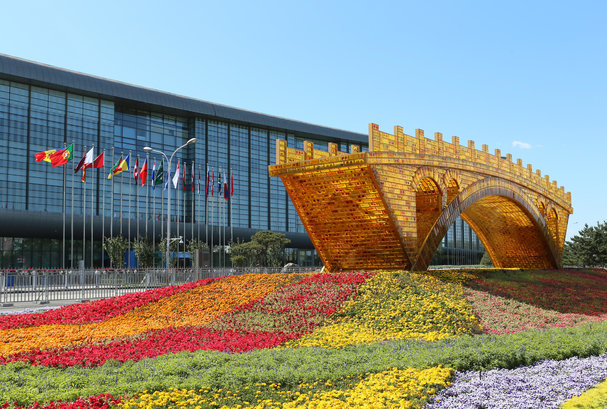
The Golden Bridge of Silk Road structure outside the National Convention Center in Beijing, where global leaders met to discuss China's ambitious plans for the region. Credit: Xinhua / Alamy Stock Photo
China trades science along ancient Silk Road
The ‘One Belt, One Road’ initiative will expand scientific collaborations with 64 countries in the region.
30 May 2017

Xinhua / Alamy Stock Photo
The Golden Bridge of Silk Road structure outside the National Convention Center in Beijing, where global leaders met to discuss China's ambitious plans for the region.
China has ambitious plans to increase its science and technology collaborations with countries along the ancient Silk Road, part of the country’s grand infrastructure expansion across the region. The president of the Chinese Academy of Sciences (CAS), Bai Chunli, said as part of China’s ‘One Belt, One Road’ plan, a science and technology collaboration network, initiated by CAS in early 2016, will be completed around 2030. The network will support regular meetings between government officials, joint labs, research projects and the free-flow of scientists.
Bai’s remarks at a news conference on 9 May came just days before leaders of 28 nations gathered in Beijing for a two-day summit in which China unveiled details of its plan to establish a vast trading network with 64 countries in Eurasia and the Middle East. President Xi Jinping committed RMB100 billion (US$14.5 billion) to fund major construction projects, such as high-speed rail lines, oil and gas pipelines, and large shipping ports. Chinese banks, state-owned enterprises, and the private sector are expected to pour more money into the movement.
As well as strengthening financial and economic ties in the region, the Chinese government will support basic research and innovation with these countries. Research activities in some of these countries are still at a nascent stage, and China has had limited scientific engagement in the region thus far.
A report published by CAS, and launched at Bai’s news conference, indicates that papers published in the Scopus database co-authored by researchers in China and each of the 64 countries between 2011 and 2015 accounted for 18% of China’s total international collaborations. The report also found that the majority of publications had very low citation rates, with the exception of papers co-authored with researchers in Singapore, Saudi Arabia, Israel, Hungary and the Czech Republic.
“The current low collaboration levels offer great potential for China to strengthen its cooperation with countries involved in the One Belt, One Road project within a short timeframe,” says Yang Liying, a senior research fellow at the CAS Documentation and Information Center and chief author of the report.
In 2016, Chinese researchers co-authored very few articles with researchers in the region in journals included in the index, from four papers with researchers in Kazakhstan to 304 papers with researchers in Russia. The article counts were significantly less than the 3,076 papers Chinese authors produced with partners in the United States, China’s top collaborator on papers in journals included in the index.
President Xi proposed the One Belt, One Road initiative in 2014, which prompted CAS, the Ministry of Science and Technology (MOST), and several other Chinese science agencies to establish joint research centres and programmes across the region. These include the Central Asian Center of Drug Discovery and Development, established in 2013 in Uzbekistan, the CAS Research Center for Ecology and Environment Central Asia, set up in Tajikistan in 2013, and the Kathmandu Center for Research and Education, a joint partnership between CAS and Tribhuvan University in Nepal in 2014.
CAS has so far trained 1,800 scientists and technicians in the region, said Bai. A plan released by MOST in 2016 to support the One Belt, One Road initiative promised, over the next five years, to sponsor an additional 150,000 scientists from across the region interested in visiting China for training and academic exchanges.
China has expanded its regional science and technology collaborations in response to the Silk Road project, says Zhao Gang, a senior research fellow at the Chinese Academy of Science and Technology for Development (CASTED), affiliated with MOST. China invests in joint labs undertaking basic research, and science parks that promote innovation and commercialization — an expansion of its earlier narrow focus on developing practical technologies.
China’s focus on building US and European Union research ties is unlikely to wane, however, says Yang at CAS. “In the near future, no doubt Chinese scientists will still primarily collaborate with their US and EU partners.” But the funding gold rush from the One Belt, One Road initiative will mean China can foster multilateral collaborations between US and EU scientists, as well as those in the region, Yang told Nature Index.
